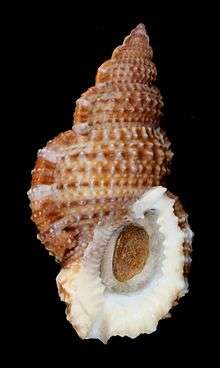Bursa granularis
Bursa granularis, common name the granular frog shell, is a species of medium-sized sea snail, a marine gastropod mollusk in the family Bursidae, the frog shells.[1]
| Bursa granularis | |
|---|---|
| A shell of Bursa granularis (Röding, 1798) | |
| Scientific classification | |
| Kingdom: | |
| Phylum: | |
| Class: | |
| (unranked): | |
| Superfamily: | |
| Family: | |
| Genus: | |
| Species: | B. granularis |
| Binomial name | |
| Bursa granularis (Röding, 1798) | |
| Synonyms[1] | |
 Apertural view of Bursa granularis (Röding, 1798) with operculum. | |
Distribution
This marine species occurs in the Indo-West Pacific, off New Zealand, in the Caribbean Sea, the Gulf of Mexico and the Lesser Antilles.
Habitat
Minimum recorded depth is 0 m.[2] Maximum recorded depth is 256 m.[2]
gollark: I could, honestly, *mostly* run my services off a raspberry pi.
gollark: It's easy to reboot it if it implodes, too, except when I go on holiday to destroy the environment.
gollark: Ah, well, I have sole control over mine.
gollark: It is, however, a large ex-NHS tower server plugged into the magic internet box™.
gollark: Ours isn't actually connected to the house, so there is literally no power or wired internet connectivity, and it's probably not very dry.
References
- Bursa granularis (Röding, 1798). WoRMS (2009). Bursa granularis (Röding, 1798). Accessed through: World Register of Marine Species at http://www.marinespecies.org/aphia.php?p=taxdetails&id=216964 on 16 July 2012 .
- Welch J. J. (2010). "The "Island Rule" and Deep-Sea Gastropods: Re-Examining the Evidence". PLoS ONE 5(1): e8776. doi:10.1371/journal.pone.0008776.
- Dautzenberg, Ph. (1929). Contribution à l'étude de la faune de Madagascar: Mollusca marina testacea. Faune des colonies françaises, III (fasc. 4). Société d'Editions géographiques, maritimes et coloniales: Paris. 321-636, plates IV-VII pp.
- Spry, J.F. (1961). The sea shells of Dar es Salaam: Gastropods. Tanganyika Notes and Records 56
- MacNae, W. & M. Kalk (eds) (1958). A natural history of Inhaca Island, Mozambique. Witwatersrand Univ. Press, Johannesburg. I-iv, 163 pp.
- Drivas, J. & M. Jay (1988). Coquillages de La Réunion et de l'île Maurice.
- Michel, C. (1988). Marine molluscs of Mauritius. Editions de l'Ocean Indien. Stanley, Rose Hill. Mauritius
- Steyn, D.G. & Lussi, M. (1998) Marine Shells of South Africa. An Illustrated Collector’s Guide to Beached Shells. Ekogilde Publishers, Hartebeespoort, South Africa, ii + 264 pp. page(s): 72
- Branch, G.M. et al. (2002). Two Oceans. 5th impression. David Philip, Cate Town & Johannesburg
- Spencer, H.; Marshall. B. (2009). All Mollusca except Opisthobranchia. In: Gordon, D. (Ed.) (2009). New Zealand Inventory of Biodiversity. Volume One: Kingdom Animalia. 584 pp
- Rosenberg, G., F. Moretzsohn, and E. F. García. 2009. Gastropoda (Mollusca) of the Gulf of Mexico, Pp. 579–699 in Felder, D.L. and D.K. Camp (eds.), Gulf of Mexico–Origins, Waters, and Biota. Biodiversity. Texas A&M Press, College Station, Texas.
This article is issued from Wikipedia. The text is licensed under Creative Commons - Attribution - Sharealike. Additional terms may apply for the media files.